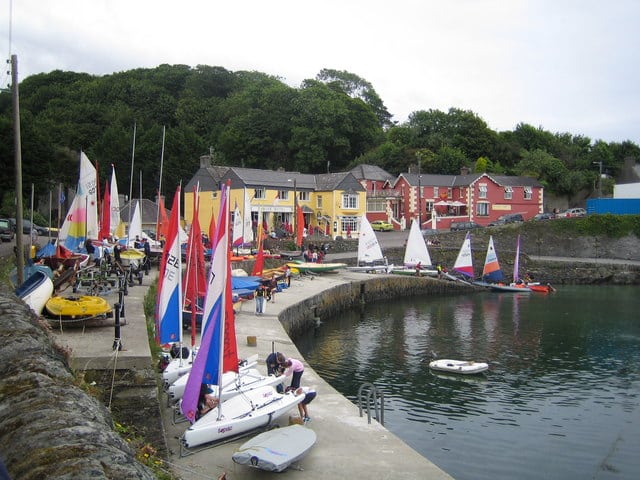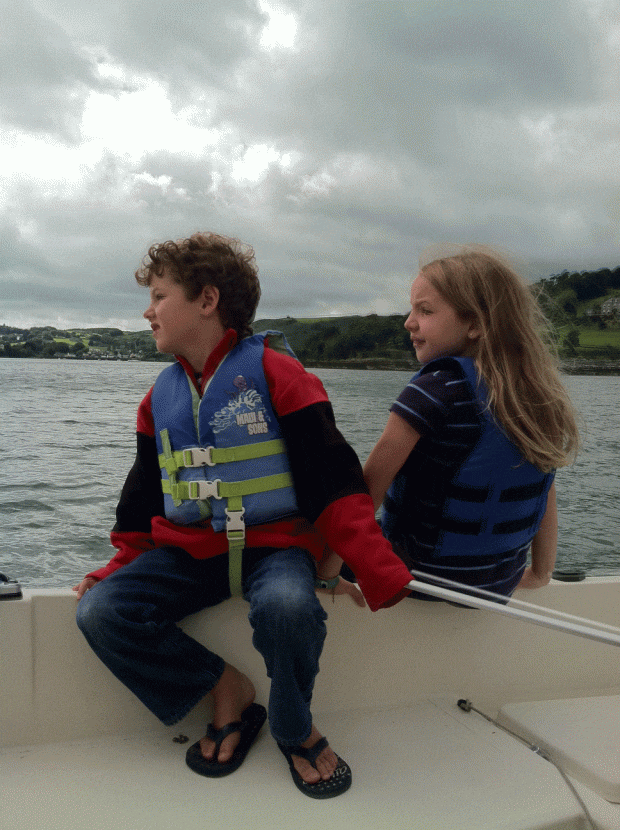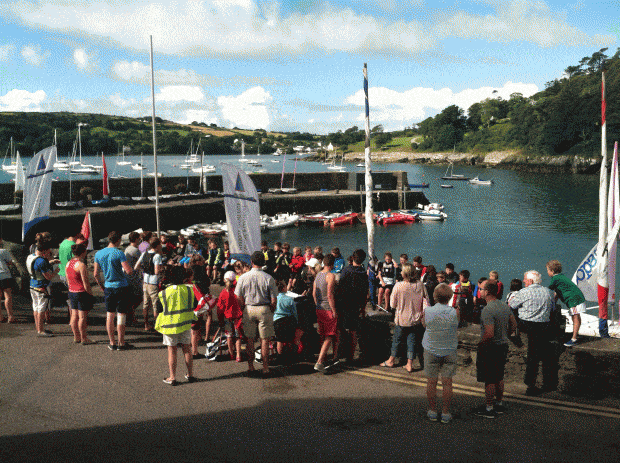
Glandore Harbour Yacht Club Sailing School
****Despite my own love of sailing, I’ve never had much luck getting my kids (11 and 8) interested in sailing school. Sure, they’ll come sail with me (if I beg, threaten, or plead, depending on the circumstances–it’s enough to make me fantasize about Burwicking them). But it has been clear that an affinity for sailing, and a desire to learn how to sail, hadn’t quite displaced their modern inclinations toward Percy Jackson books, Minecraft, Dragonvale, and Instagram. I didn’t sweat it too much because they get plenty of exposure to the sport, and I figured it would either take or it wouldn’t. But, clearly, whatever I was trying–mainly taking them on weekend cruises, with some daysailing thrown in– wasn’t quite doing the trick.

This is what I have to offer …
********Luckily, this summer–mostly, because they wanted to do what the other kids were doing–they finally gave sailing school a shot. It was a slightly exotic sailing school, being located in the pretty village of Glandore on the southwest coast of Ireland (we make semi-annual pilgrimmages to Glandore during the summer because it’s hard to pass up cool, rainy, weather, the Irish landscape, and real Guinness draft). But my patience was rewarded. They liked it. The Glandore Harbour Yacht Club Sailing School delivered. My kids say they want to do it again. They seem to have brought their enthusiasm for sailing back across the Atlantic. And in a world that is always trying to figure out how to get kids interested in sailing, I am now trying to figure out why.
I have to start with the fact that Glandore harbour has always been an excellent place to sail, which is one reason that cruising icon Don Street lives in Glandore (another is that he married a sweet Irish lass), and can often be seen roaming the pier, Heineken in hand, or rowing out to his Dragon for a little evening racing (Warren Brown Jr., of the War Baby (ex-Tenacious) Browns, is also a local). It is beautiful, there is usually wind, and the harbor is nicely protected yet full of interesting geographical hazards and landmarks. It didn’t hurt that this summer featured more sun than anyone can remember.
Dragons racing in Glandore.
Then there is the lure that in Glandore, if you want to get to know and hang out with other kids, you go to sailing school. It used to be that most of the kids who sailed were summer visitors from the U.K., the U.S., and elsewhere, with many of the Irish kids going in for rowing. But over the years the GHYC and its sailing school has grown leaps and bounds (this year they inaugurated a new clubhouse), and now sailing seems to be the preferred option for kids from everywhere.
During the busy season, the school has some 85 or more kids in the various levels, which run from “Taste Of Sailing” up through “Go Racing” and “Adventure.” The day starts at 10, with everyone gathering at the pier, and finishes at 5. The kids are out on the water in most weather, and parents have an extra incentive to have kids in sailing school because it gives them lots of free time to go do their own sailing, walking, biking, or hanging out in pubs.
Enrolling the kids in sailing school was just the first step. I then had the pleasure (and relief) of seeing them really enjoy it. And that is because it was, well, fun. Apart from messing around on boats (Toppers, Topazes, and Visions), spending lots of time capsizing them and arguing about who would get the “dry cap,” they spent a lot of time jumping off the pier, and enjoying hot fries and hot chocolate from the Marine Bar after school wrapped up for the day.
It’s hard to emphasize how important fun is for a successful sailing school. And GHYC knew how to show the kids a good time. There was a cake day (where everyone baked and brought in cakes, with prizes for the best), a sail to nearby Union Hall for ice cream at Fuller’s market, and a picnic day on Rabbit Island. Sure, there were routine sailing school drills. But the kids learned a lot about sailing simply because a lot of the time they were on boats having a good time doing other things.

My daughter and her friends with their winning Cake Day entry.
And even when there was too much wind for the beginners to go out, no problem. Take the mast out of a Topaz, stick a bunch of kids on it inside the harbor wall, and see if they can get it from one place to another using a garbage bag for a sail. And then take that away and let them learn about weight placement and how easy it is to turtle a dinghy (and how hard it is to right it without a centerboard).
Learning without knowing you are learning is always the best way. And while I don’t have much experience with American sailing schools, my impression is that there is more emphasis on preparing kids for the cutthroat world of Opti sailing and junior competition. That seems like a recipe for potential burnout. If a kid wants to race, first the kid must love simply being on a dinghy out on the water. And I am happy with any sailing school that emphasizes that part along with safety and seamanship.
The ISA training gets more serious, of course, as the sailors progress. The courses are structured as a well-defined progression, and each level teaches new and additional skills. When a kid masters a required skill, that is noted in an ISA logbook that each kid carries through the entire program. Master enough, and you move on to the next level. There is lots of chatter and excitement at the end of each course over whether a child is graduating to the next level or not. And, yes, sometimes kids fail to move up (ISA is more interested in turning out competent sailors than boosting egos). The logbooks remind me of the skills books good ski schools use, and they are an excellent way to focus a child on where he or she is, and what skills need attention. My kids eat that stuff up because it gives them a concrete look at what they need to achieve to keep moving up the ladder.
The system also makes it easy for a child to make a multi-year commitment to the sport because they know they are not “done” until they have climbed to the top of the course ladder (and many come back as instructors). At the same time, they are encouraged to get on the helm right away, and I have started to adapt to my new role as rail meat, jib trimmer, and early warning system regarding imminent collisions. It’s a role I’ve been waiting a long time to play.

Morning brief, before going sailing.
Now we are back in Washington, D.C., and the fall sailing season on the Chesapeake looms. I’ll be interested to see whether their Glandore sailing school enthusiasm translates into an interest in sailing (rather than simply being on) the Beneteau 36.7. Already they are agitating for a Topaz dinghy to sail by themselves on the Rhode River of the Chesapeake Bay, and telling their friends all about what they learned and saw out on Glandore’s waters.
Thanks, GHYC sailing school.









